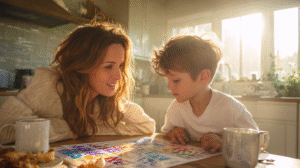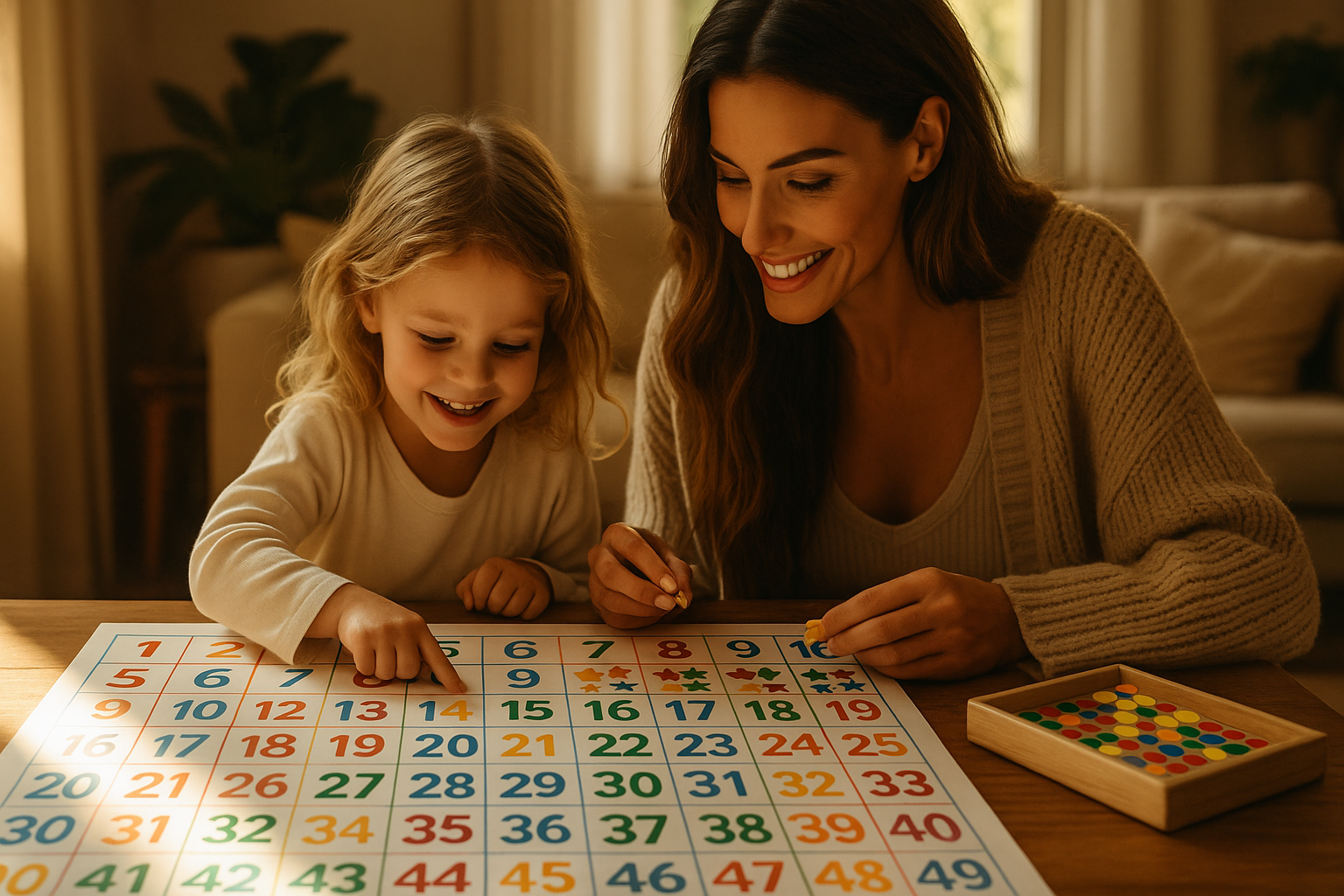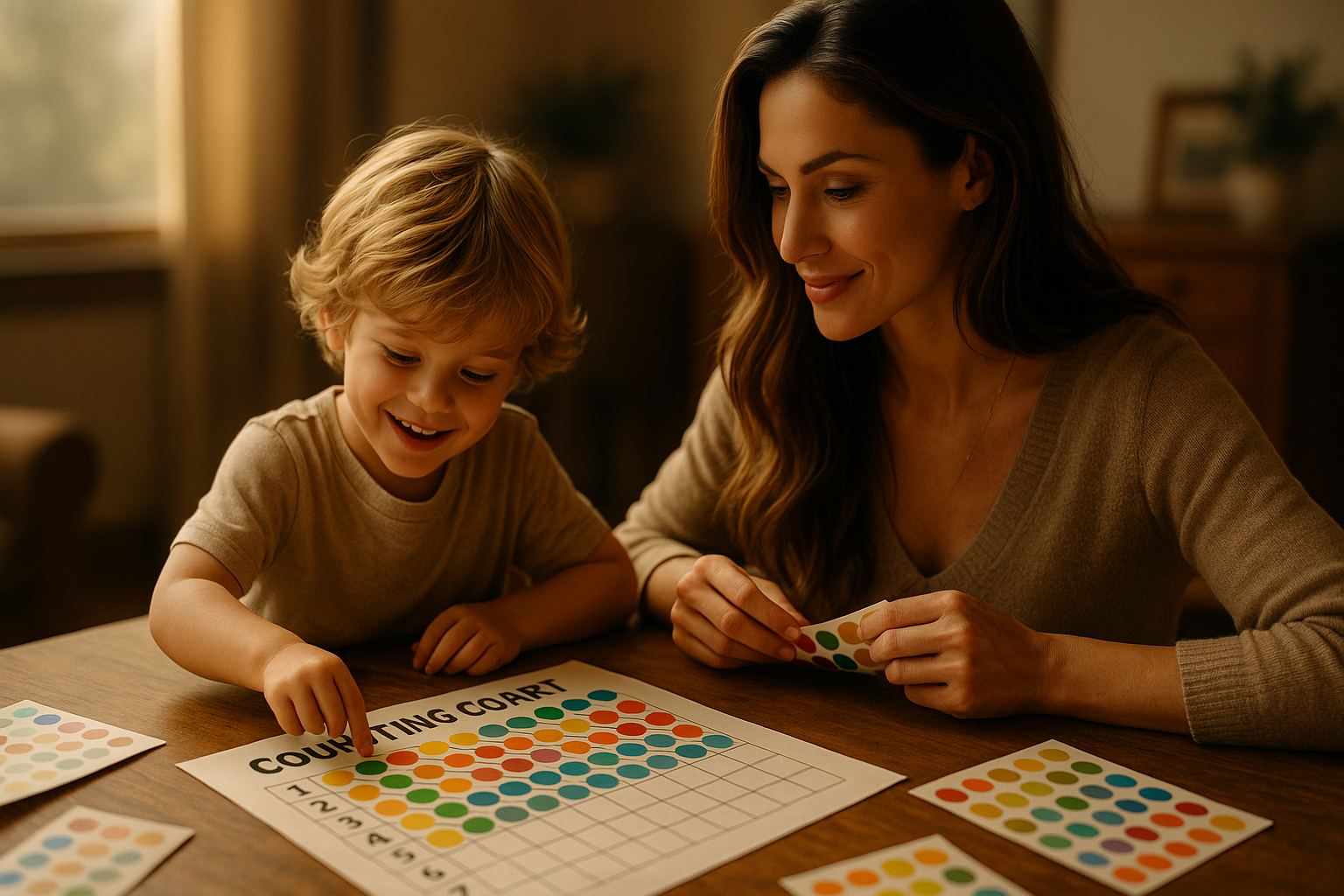
Morning Calendar Math: A Daily Routine to Build Number Sense
Morning Calendar Math: A Daily Routine to Build Number Sense As a former elementary math teacher turned homeschooling mom, I

“I don’t want to count anymore!” My four-year-old’s dramatic declaration echoed through our living room last Tuesday evening. There we sat, surrounded by scattered counting bears and worksheets that had somehow become the enemy rather than fun learning tools. As a former middle and high school math teacher, I thought I had this early childhood education thing figured out. Boy, was I wrong.
After years of teaching algebra and geometry to teenagers, I discovered that building foundational early math skills for preschoolers required a completely different approach. Traditional counting exercises were leaving both my kids frustrated and me questioning my teaching abilities. That’s when I remembered something I’d used successfully with my reluctant high school students: the power of visual progress tracking.
The next morning, I pulled out some colorful stickers and created our first counting chart. What happened next completely transformed how we approach developing early math skills in our house. Suddenly, counting became a game instead of a chore, and both my first-grader and my four-year-old were begging for more math practice.

Sticker charts tap into children’s natural love of rewards and visual progress tracking. When kids see their accomplishments displayed in bright, colorful stickers, they develop a sense of pride and ownership over their learning journey. This visual representation makes abstract mathematical concepts feel more concrete and achievable for young minds, which is crucial when developing early math skills.
The immediate gratification that stickers provide helps maintain motivation during those challenging early counting stages. I’ve watched my kids light up when they earn a sticker for correctly counting to ten or identifying number patterns. This positive reinforcement creates neural pathways that associate math practice with joy rather than struggle.
Research in child development shows that visual learners, which many young children are, process information more effectively when they can see their progress. Sticker charts provide that crucial visual feedback while building number sense through repeated practice and celebration of small victories.
Young children thrive on routine and predictability, and sticker charts create a structured system they can understand and anticipate. The clear cause-and-effect relationship between counting success and sticker rewards helps build mathematical confidence from the ground up, forming the foundation for all future early math skills development.
💡 Teacher Mom Tip: Choose stickers that match your child’s interests! My daughter loves unicorns, so unicorn stickers make counting practice feel like magical playtime rather than work.
For my four-year-old, I start with simple charts that focus on counting from 1 to 10. Each successful count earns one sticker, and we celebrate every achievement with enthusiasm. The key is keeping the goals achievable—nothing kills motivation faster than tasks that feel impossible to a preschooler.
My first-grader uses more complex charts that include skip counting by 2s, 5s, and 10s. We also incorporate number recognition activities where she earns stickers for identifying numbers in different contexts, like on license plates during car rides or house numbers during our neighborhood walks. These varied activities strengthen early math skills across multiple domains.
I’ve learned that personalizing each chart makes a huge difference in engagement levels. We decorate the borders together, choose themes they love, and even let them help design the reward system. This collaborative approach gives them ownership over their learning process and makes counting practice feel like creative play.
The size and layout of the chart matters tremendously for maintaining interest. I use poster board for our main counting charts because the large format makes their progress feel significant and impressive. Smaller charts work well for daily practice sessions or travel activities when we’re on the go.
💡 Teacher Mom Tip: Laminate your charts so you can reuse them with dry-erase markers! This saves money and lets kids watch their progress accumulate over multiple weeks without starting over.
Beyond simple counting, I use sticker charts to teach number patterns and mathematical relationships that form the foundation of early math skills. We create charts where every fifth sticker is a different color, helping my kids visualize counting by fives naturally. This visual pattern recognition transfers beautifully to later mathematical concepts like multiplication tables.
I also design charts that show number bonds and simple addition facts through strategic sticker placement. For example, we might have a chart where kids earn two stickers for counting to five, then three more stickers for counting from six to ten. This physical representation helps them understand that 5 + 5 = 10 in a tangible, hands-on way.
Comparative charts work wonderfully for teaching concepts like “more than” and “less than” through visual comparison. We’ll create side-by-side tracking where they can visually compare their progress on different counting skills. These comparisons naturally lead to discussions about mathematical relationships and number sense development.
The spatial arrangement of stickers also reinforces fundamental number concepts that will serve them throughout their mathematical education. I intentionally design charts where stickers are placed in groups of five or ten, mimicking the base-ten system that underlies all our number work and strengthens essential early math skills.
💡 Teacher Mom Tip: Use different shaped stickers for different achievements—stars for counting to 20, circles for number recognition, hearts for helping siblings with math. This creates a visual legend of their diverse math skills!
The magic happens when counting practice extends beyond formal chart time into everyday activities and real-world applications. We count stairs as we climb them, earning stickers for accurate counting during these natural moments. This integration helps kids see math as part of life rather than a separate school subject confined to worksheets.
Grocery shopping becomes a treasure hunt for number practice and mathematical discovery. My kids earn stickers for finding specific numbers on price tags, counting items as we place them in our cart, or identifying which aisle numbers come next in sequence. These real-world applications make abstract number concepts feel relevant and immediately useful while reinforcing early math skills in practical contexts.
Cooking provides incredible opportunities for meaningful counting practice that connects to practical life skills. We count ingredients, measure cups, and track cooking times, with stickers rewarding accurate mathematical observations. This practical application helps solidify number concepts while building confidence in everyday math situations.
Even cleanup time becomes math practice in our house through creative integration of counting activities. We count toys as we put them away, sort items by quantity, and celebrate these everyday math moments with sticker rewards. This approach helps kids recognize that mathematical thinking surrounds us everywhere we look.
💡 Teacher Mom Tip: Keep a small notebook and mini stickers in your purse for spontaneous counting opportunities during errands. These unexpected practice moments often become the most memorable and effective!
Some children become overly focused on earning stickers rather than learning the mathematical concepts behind the counting practice. When this happens, I shift emphasis back to the counting achievement itself, celebrating their mathematical thinking and problem-solving before awarding the sticker. This refocuses attention on learning rather than just external rewards, ensuring that early math skills remain the true priority.
Sibling competition can either motivate or discourage, depending on each child’s personality and learning style. I’ve learned to create individual goals that celebrate each kid’s unique progress rather than comparing their achievements directly. Different colored charts for different children helps maintain this individual focus while still allowing family math celebrations.
When motivation wanes, which inevitably happens with any reward system, I refresh our approach by introducing new sticker designs, changing chart themes, or adding collaborative family challenges where everyone works together toward a shared counting goal. Variety and novelty keep the system feeling fresh and exciting rather than routine.
Perfectionist tendencies can make some children afraid to try challenging counting tasks if they might make mistakes. I address this by creating “effort” categories where kids earn stickers simply for attempting difficult counting challenges, regardless of perfect accuracy. This builds confidence, resilience, and a growth mindset toward mathematics.
💡 Teacher Mom Tip: Take photos of completed charts before starting new ones! Create a digital portfolio of their mathematical journey—kids love looking back at their progress, and it’s incredible documentation for parents too.
The transformation in my kids’ relationship with numbers has been remarkable to witness as both a parent and former educator. Math anxiety, which I’d seen destroy confidence in so many of my high school students, simply doesn’t exist in our house anymore. Instead, my children approach new mathematical challenges with curiosity, excitement, and genuine enthusiasm for learning.
What started as a desperate attempt to make counting practice more engaging has evolved into a comprehensive system for building mathematical confidence from the earliest ages. The sticker charts aren’t just tracking progress—they’re creating positive associations with mathematical thinking that will serve my kids throughout their entire educational journey and beyond, establishing solid early math skills that will support all future learning.
The best part is watching them naturally apply counting skills in situations where no stickers are involved or expected. They count for the pure joy of discovery now, because we’ve made the learning process so inherently positive and rewarding from the very beginning. This intrinsic motivation is the ultimate goal of any educational approach.
Our counting adventures have taught me that the simplest tools often create the most profound learning breakthroughs. Sometimes the path to mathematical confidence is paved with colorful stickers and celebrated small victories, one number at a time.
Every sticker tells a story of mathematical discovery, one joyful count at a time.

Morning Calendar Math: A Daily Routine to Build Number Sense As a former elementary math teacher turned homeschooling mom, I

Brushing Teeth Countdown: 5 Powerful Fun Tips for Kids As a former math teacher turned mom of two, I thought

Cooking Fractions for Kids: 7 Fun & Tasty Ways to Learn Math Last Tuesday, my 8-year-old son Jake stared at
*Also read:
25 Brilliant LEGO Math Activities to Build Number Sense and STEM Skills at Home
Teach Kids to Tell Time: The Clock Game Every Parent Should Try at Home